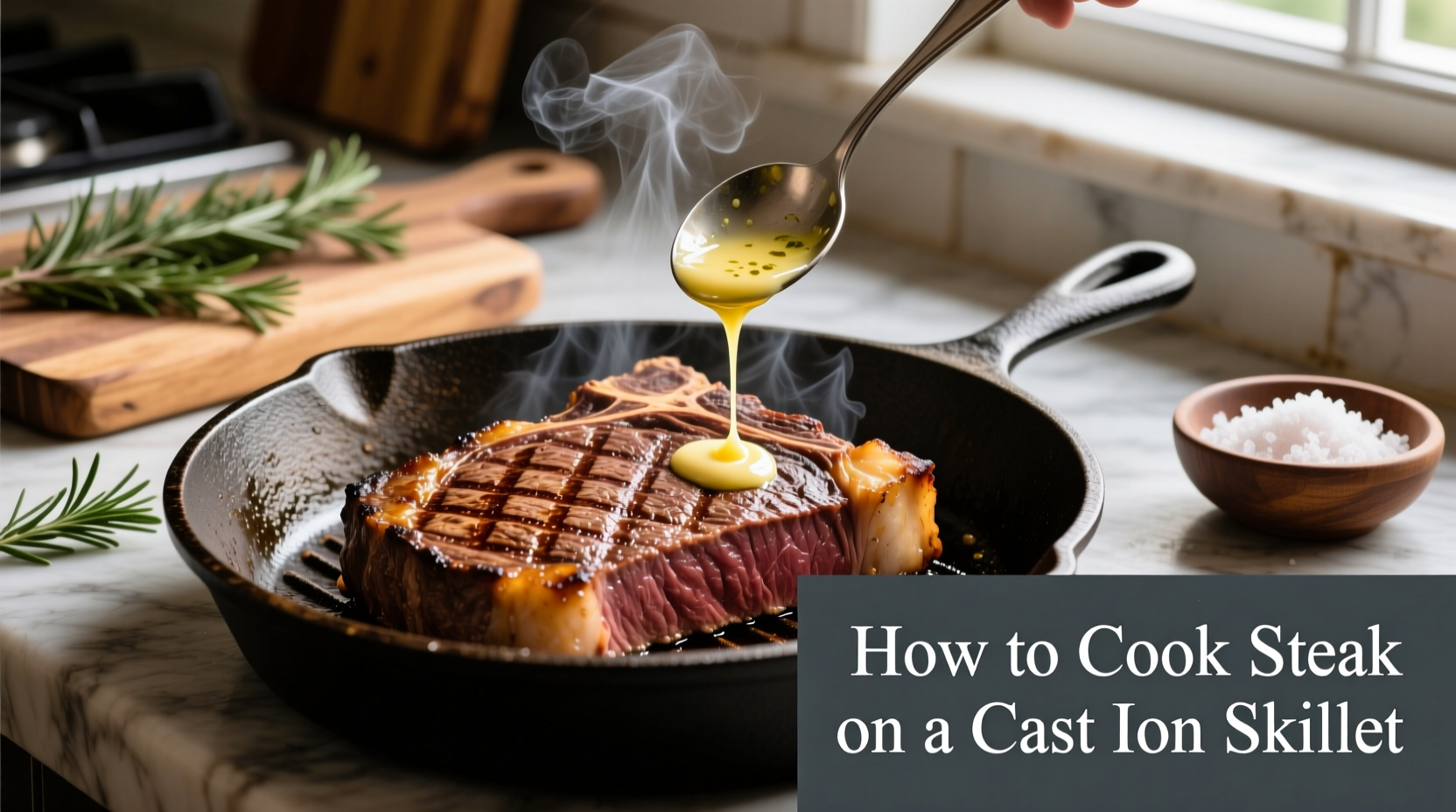Perfectly sear a restaurant-quality steak at home by preheating your cast iron skillet for 5 minutes until smoking hot, seasoning your room-temperature steak generously with coarse salt, cooking for 3-4 minutes per side for medium-rare, then finishing with butter and aromatics. Rest for 5-10 minutes before slicing against the grain for maximum juiciness.
Mastering cast iron steak cooking transforms your weeknight dinner into a culinary triumph. Unlike other methods, cast iron's exceptional heat retention creates an unparalleled crust while maintaining perfect interior doneness. This guide delivers professional techniques refined through decades of kitchen experience, eliminating guesswork for consistently exceptional results.
Why Cast Iron Reigns Supreme for Steak
Cast iron's thermal mass outperforms stainless steel and non-stick alternatives when searing steaks. The American Meat Science Association confirms that surface temperatures above 400°F (204°C) trigger optimal Maillard reaction—the chemical process responsible for complex flavor development and that coveted brown crust. Cast iron maintains this critical temperature even when a cold steak makes contact, preventing the sticking and steaming that plague inferior cookware.

Essential Preparation Steps
Dry your steak thoroughly with paper towels 30 minutes before cooking—moisture is the enemy of proper searing. Patience here prevents steam formation that would lower the skillet's temperature. Season generously with coarse kosher salt (1 teaspoon per pound) and freshly ground black pepper at least 40 minutes prior to cooking, allowing the salt to penetrate while drawing out excess surface moisture.
Cast Iron Steak Cooking Timeline
Follow this precise sequence for flawless results:
- Preheat skillet on medium-high for 5 minutes until smoking hot (use infrared thermometer to verify 450-500°F)
- Add high-smoke point oil (avocado or grapeseed) just before steak placement
- Sear first side without moving for 3-4 minutes until crust forms
- Flip and sear second side for equal time
- Add butter, garlic, and herbs during final 2 minutes, basting continuously
- Rest steak on wire rack for 5-10 minutes (critical for juice retention)
Steak Cut Reference Guide
| Steak Cut | Thickness | Recommended Cook Time | Internal Temp (Medium-Rare) |
|---|---|---|---|
| Ribeye (bone-in) | 1.5 inches | 4-5 minutes per side | 130-135°F |
| New York Strip | 1.25 inches | 3.5-4 minutes per side | 125-130°F |
| Filet Mignon | 2 inches | 5-6 minutes per side | 120-125°F |
| Flat Iron | 1 inch | 3 minutes per side | 130°F |
Contextual Considerations for Cast Iron Success
While cast iron excels for most steaks, recognize these important boundaries: extremely thin cuts (<0.75 inches) risk overcooking before proper crust development, and lean cuts like flank steak benefit more from high-heat grilling. The USDA Food Safety and Inspection Service recommends using an instant-read thermometer for accuracy—visual cues alone can't reliably indicate doneness. Always verify internal temperatures match your desired outcome: 120-125°F for rare, 130-135°F for medium-rare, 140-145°F for medium.
Avoiding Common Pitfalls
Most home cooks make these critical errors: moving the steak too soon (preventing crust formation), overcrowding the skillet (causing steam instead of sear), and skipping the essential resting period. When flipping, use tongs rather than piercing with a fork to preserve juices. For thicker cuts exceeding 1.5 inches, finish in a 350°F oven after initial searing to achieve proper internal temperature without over-browning the exterior—a technique validated by the Culinary Institute of America's cooking methodology.
Finishing Touches for Restaurant Results
Elevate your steak during the final minutes by adding a tablespoon of unsalted butter, two smashed garlic cloves, and fresh thyme or rosemary to the skillet. Tilt the pan and continuously spoon the melted butter over the steak surface—a process called basting that infuses additional flavor. Remove the steak when 5°F below target temperature, as carryover cooking will raise the internal temperature during resting. Slice against the grain using a sharp chef's knife for maximum tenderness.
Cast Iron Maintenance for Longevity
Proper care ensures your skillet performs optimally for decades. After cooking, clean while still warm using coarse salt and a chainmail scrubber—never soap. Reheat on stove until completely dry, then apply thin layer of vegetable oil while warm. Store in a dry place with paper towel inside to absorb moisture. This seasoning process creates the non-stick surface essential for perfect steak searing, as documented by the American Institute of Baking's research on cast iron performance.











 浙公网安备
33010002000092号
浙公网安备
33010002000092号 浙B2-20120091-4
浙B2-20120091-4